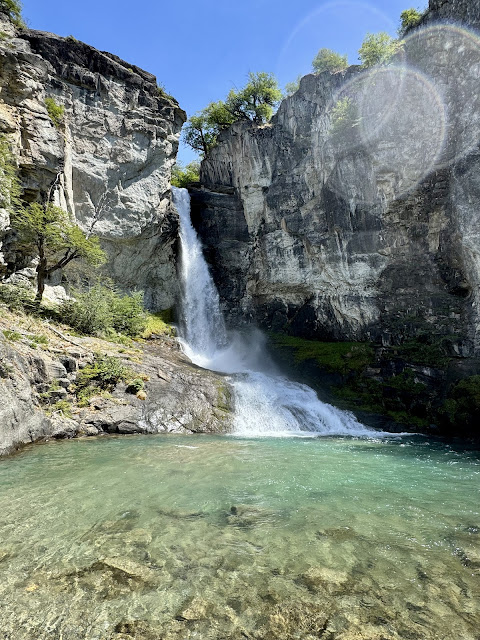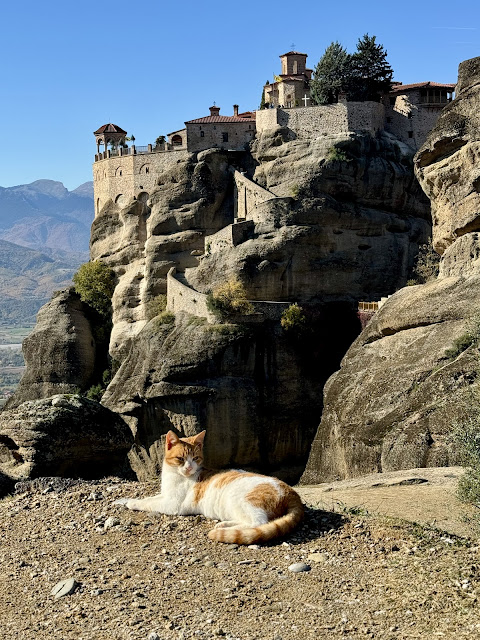Tuesday, December 31, 2024
Perito Moreno Glacier
Sunday, December 29, 2024
Final El Chalten Hike
Lago del Desierto
 |
| Lago del Desierto |
 |
| Lago Huemul in front of Glacier Huemul |
 |
| 1/2 marghereta 1/2 pepperoni |
Saturday, December 28, 2024
Patagonian Wildlife
Hiking Capital of Argentina
 |
| Rio de las Vueltas |
Friday, December 27, 2024
Now it's Argentina's turn
We've had a termendous three days in Torres del Paine, but it's time to visit the Argentinian portion of Patagonia. Our hotel stay in Cerro Castillo, Chile was excellent, but the bonus to staying there was that we were practically next door to the border crossing.
Crossing the border required parking at the Chilean border station and going inside to get passports stamped. We also had paperwork that had to be stamped as well -- a cross-border permit -- that allowed us to take our rental car from Chile into Argentina. Once we completed that, we drove about 5 miles to the Argentinan station, actually crossing the border about halfway there. It was the same process. All told, we completed both stations in under 45 minutes which was great.
 |
| Guanaco |
 |
| Crested Caracara |
The best part of the drive was the arrival in El Chalten. We were greeted with stunning views of snow-capped peaks and the famous outline of Mount Fitzroy. The logo for clothing company Patagonia is based on Fitzroy. While we had some clouds during our arrival, it was still an awesome site to see. I went out early today and captured this photo with clear blue skies. Awesome indeed.
Thursday, December 26, 2024
Wait....wasn't this last year's trip?
Grey Glacier is part of the Southern Patagonian Ice Field, which is the second-largest ice field after Antarctica. About 85% of this ice is in Chile and the remainder in Argentina. Unfortunately, like most of the other glaciers we have had the good fortune to see around the world, it has retreated significantly due to global warming.
After two long days of hiking, we knew we needed a break so no hiking today. We did have a full day of adventure and gorgeous scenery driving from the east side of the park to the west side and back again. Some of our Christmas Day adventures:
- Coming across a Chilean gaucho and three of his herding dogs trying to corral a lone sheep that had gotten outside the fence. They were next to the road, and we had to stop the car to avoid hitting them. The dogs then used our car to trap the sheep at the back as we heard a soft thud from the trunk. The sheep just laid down cowering as we drove away, and the gaucho scooped it up and put it on the other side of the fence.
- Giving a hiker from Switzerland a ride back to his car. He did the "W" circuit with some friends and he drew the short straw to go back and get their car. He figured he would have lots of opportunity to hitch a ride, but soon realized there really weren't many people driving through the park. We saved him at least 10 miles.
- Having a scavenger hunt photographing all of the unique "Deer Crossing" signs, except they weren't for deer. They were for guanacos, armadillos, and my personal favorite -- the ostrich. That's right, we saw signs along the road warning us to look out for giant running birds. The South American ostrich is called a Rhea. We also saw a sign for pumas. Mona's take -- since they're telling us to watch out for pumas, we should at least be able to see one. We did not. There was also a sign featuring a wind sock, which I guess is a universal sign for high winds and not that one might cross the road in front of you.
- Taking an unplanned detour to catch a waterfall with the Towers in the background. Made us late for our lunch reservation, but totally worth it.
- Winning Mona a free cocktail on the boat for correctly answering a trivia question on the journey back from the glacier. How deep is Grey Lake?? 480 meters.
 |
Wednesday, December 25, 2024
Torres del Paine National Park
Torres is the spanish word for Towers, and our first day we hiked to the Towers for which the park gets its name. The last kilometer is very steep, and is referred to as a rock scramble in hiking parlance.
 |
| We made it to the base of the Towers |
As the name implies, it's very rocky -- but it also has its fair share of boulders and large rocks to climb over. It's not uncommon to see people sit and slide down one of them on the way down due to the steepness. One of us may have done this as well 😀. Not including stops, this was about a 10.5 hour hike for us.
The trail to the Towers is part of a larger multi-day hike called the "W" circuit because it is in the shape of a W. Most people who come here come with the intention of doing this circuit in about 5 days and camping along the way. We didn't have enough time to do the entire circuit, plus we're not campers. You have to hike with all of the extra gear, and we'd rather spend the day hiking and then go back to a comfy bed and shower. There's an even longer 10-day hike doing what's referred to as the "O" circuit because you're circling the entire section with the Towers.
 |
| Lake Pehoe -- yes it's really that blue! |
We've had great weather so far, with lots of sunshine and no rain. Hope that continues today. It is very windy here which we knew ahead of time. While not a constant strong wind, when it gets going, it's hard to keep a hat on unless it's a stocking cap.
The landscape and the views are glorious. Seeing places like this reaffirm my love of the mountains.
Sunday, December 22, 2024
Our Christmas Patagonian Adventure
Wednesday, November 20, 2024
Farewell Greece. Until Next Time.
Meteora
 |
| Roussanou |
 |
| Varlaam |
With the exception of St. Stephen, each monastery requires an uphill walk and lots of stairs.
 |
| Holy Trinity |
We had a beautiful day in which to explore and absorb this majestic landscape. The leaves here are now starting to change colors, adding another layer of beauty. This has been a great way to finish up our trip before heading back to Athens and our flight home.
 |
| St. Nikolaos |
 |
| St. Stephen |
 |
| Great Meteroron |
Tuesday, November 19, 2024
Delphi
 |
| In front of the Treasury of Athenians |
Nafplio and Epidauros
 |
| Lion of Bavaria |
 |
| Lucerne Lion Monument |
 |
| Church of Agioi Pantes |
Monday, November 18, 2024
Crossing Bridges
 |
| Lion Gate |
 |
| Wendy crossing a 3500-year-old bridge |
Lesvos
 |
| Still seeing the roots |




























